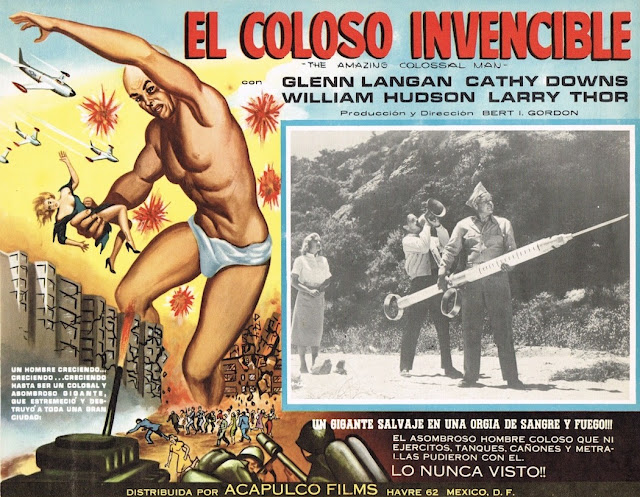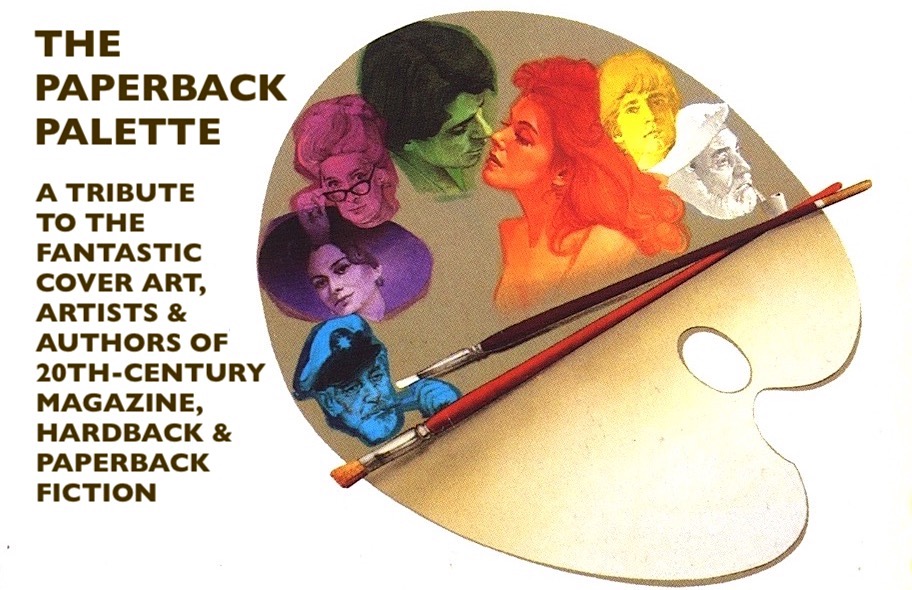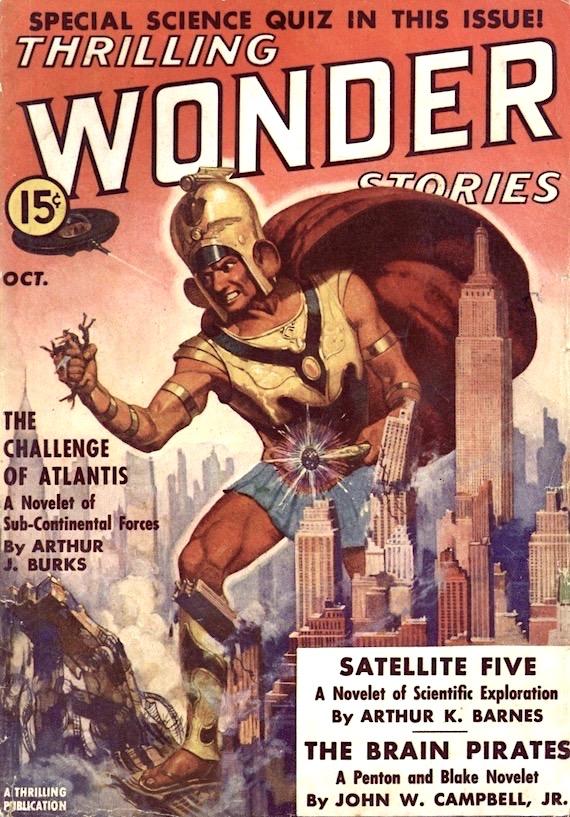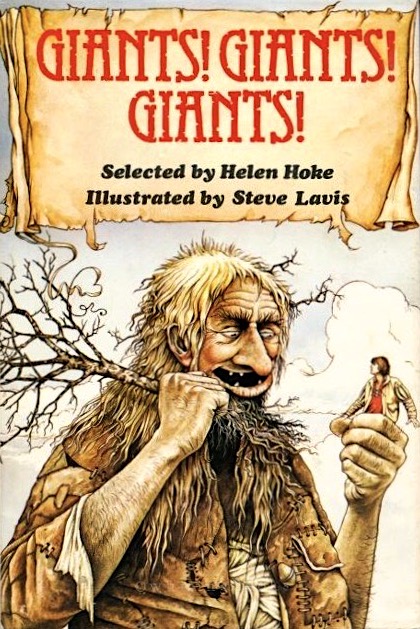Giant humans, as well as 'giant human hands,' have been featured on many a pulp magazine and book cover too. Certainly before 1940, but especially since.
Here's a selection of GIANT HUMANS from all three popular mediums.
Brown's depiction of Allison Hayes as a giantess causing destruction along an elevated freeway is probably the most enticing poster art ever painted for a 1950s SF film. However, because the film is virtually devoid of quality special-effects, and painfully dull to watch, it's become almost insignificant when compared to its many 1950s counterparts. The film has never lived up to our heightened expectations as brought on by the posters enormous appeal. So while the movie itself hasn't stood tall in the test of time, Brown's poster has and will. Of the more than 250 movie posters that Brown produced in his lofty career, Attack of the 50 Ft. Woman is probably his most coveted. For cinephiles everywhere, it's as big as they come.
"See A Female Colossus... Her Mountainous Torso, Skyscraper Limbs, Giant Desires!"
Daniel Burns has been an on-set designer and art director across hundreds of diverse projects, for film and television and commercial production and more besides. He has worked with Guillermo del Toro and James Cameron, to name drop two, across a broad range of genres. He has also worked on the films Fantastic Voyage, IT (chapter 2), Pacific Rim Uprising and Asura. Some of Burns' clients include 20th Century Fox, Warner Bros, Legendary Pictures, Sony Pictures and the SYFY Channel. His tools of the trade are Zbrush, #DS Max, Keyshot, Vue Xstream, Photoshop, and, much to my relief, a "good ole graphite pencil."
 |
| CLICK TO ENLARGE |
The story: Lt. Colonel Glenn Manning is inadvertently exposed to a plutonium bomb blast and although he sustains burns over 90% of his body, he survives. Then he begins to grow, but as he grows he starts losing his mind. By the time he stops he is 50 ft tall, insane and rampaging across the landscape.
Glenn Manning: "At high school I was voted the guy most likely to reach the top." "Perhaps it isn't I who's growing, but it's everyone who's shrinking!" "Why don't you ask me what it feels like to be a freak?" "I just don't want to grow anymore. I don't want to grow anymore!"
 |
| CLICK TO ENLARGE |
The story: Lt. Colonel Glenn Manning's sister is convinced that her brother survived after being exposed to radiation from an atomic bomb. Joyce goes to Mexico with two companions and finds that he has, in fact, survived, but was left disfigured and nearly mindless by the trauma of his fall. Not mindless enough to avoid going on another rampage though.
Joyce Manning: "Do you know what it's like, just sitting around waiting for news?"
Maj. Mark Baird: "You mind if I suggest a remedy? It's an old one , but it usually works. Find something else to occupy your mind. Do you have a job?"
Joyce Manning: "I write copy for an advertising agency."
Maj. Mark Baird: "Now that should help you forget your troubles."
Joyce Manning: "I can imagine myself going back to write all those tired old adjectives: "Tremendous," "Gigantic," "Colossal!" You know what they'd mean to me now, don't you? Glenn! A colossal freak, Major, and he's my brother!"The story: Susan
Winters (Talbott) is determined to find her fiancé, Bruce
Barton, who vanished in Mexico while prospecting for uranium six months
earliers. Promising any uranium they find to
wealthy mining expert "Marty" Melville (Chaney), she puts together a
search team which includes guide Russ Bradford (Craig), and pilot Lee
Brand (Drake). Finding their way to the valley Barton was investigating
when he crashed, they land and are almost immediately attacked by giant
animals--giant-sized because of exposure to high radiation levels. They
soon discover Barton is living in a nearby cave, and, like the animals,
he is now a
25-foot tall mutant
humanoid with a single eye and deformed face.
It was a monster, yet it was a man!
You'll hardly believe what your own eyes see! The Strangest Monster the World Has Ever Seen...'
The VHS formatted videocasette of VILLAGE OF THE GIANTS was released in 1985. The box art was not credited though.
"It's the Teen-Scene You've Never Seen!
THRILLING WONDER STORIES, 1938, October. Nobody does giant humans (and non-humans) like pulp magazines, although their cover art is not always credited, like here. I'm sure everyone who has ever been interested in this unique American medium has a favorite "Giant" cover. Mine can be found further down this list.
THRILLING WONDER STORIES, 1940, October. Cover art Earle Bergey.
AMAZING STORIES, 1941, January. Cover art by J. Allen St. John.
STARTLING STORIES, 1942, July. Cover art by Earle Bergey. This could easily be my favorite "Giant" cover, but actually it's not. Although as a fellow collector ya gotta love a giant who also likes to collect.
THRILLING WONDER STORIES, 1942, February. Cover art by Rudolph Belarski.
FUTURE FANTASY AND SCIENCE FICTION, 1943, October. Cover art by Milton Luros.
AMAZING STORIES, 1946, August. Cover art by Harold McCauley.
AMAZING STORIES, 1946, November. Cover art by Arnold Kohn.This is not my favorite "Giant" cover either, but that woman is definitely favored by me.
FAMOUS FANTASTIC MYSTERIES, 1946, December. Cover art by Virgil Finlay.
AMAZING STORIES, 1947, March. Cover art by Robert Gibson Jones.
AMAZING STORIES, 1949, December. Cover art by Robert Gibson Jones.
FANTASTIC ADVENTURES, 1951, December. Cover art by Robert Gibson Jones.
FANTASTIC ADVENTURES, 1952, September. Cover art by Walter Popp.
INFINITY SCIENCE FICTION, 1958, March. Cover art by Ed Emshwiller.
DRAGON MAGAZINE, 1988, December. Cover art by Larry Elmore.
AND NOW on to our next section; book covers...
'Herodotus, an ancient Greek writer, mentioned a people who lived at the back of the North Wind. George MacDonald, a Scottish writer whose books for children include THE LIGHT PRINCESS, THE PRINCESS AND CURDIE, AND THE PRINCESS AND THE GOBLIN, says that he does not think Herodotus had the right account of the tale, and he then proceeds to give us his story of a boy who actually went there. AT THE BACK OF THE NORTH WIND tells of the boy Diamond, the son of a poor coachman, and of his fascinating friendship with the North Wind, who appears in the story in many different guises. George MacDonald combines the spiritual with the everyday happenings of life in such a way as to make tham all wonderfully believable. Diamond's adventures at the Back of the North Wind is a rare and lovely book which ranks with the best in children's fiction.'
'Michael Kane had to return to Mars. The siren call of the ancient planet filled his blood with longing... both for a world that was not his own, and for the lovely Queen Shizala, the alien who claimed permanent possession of Kane's heart. But the way back lay through the matter transmitter, and the journey threatened to be more perilous than even Kane imagined! For the matter transmitter could not be controlled; when it tore him from Earth, the other end of his journey might be anyplace... or anywhen! And the mars that he discovered this time was not the Mars of his Shizala! As perilous as his early adventures had been, this Mars was far more deadly and alien!'
THE COLOSSUS OF MAROUSSI by Henry Miller was published in paperback by Pocket in 1975. The cover art was produced by Alan Magee, a prodigious illustrator who was just as celebrated for his magazine illustrations as he was for his many, many excellent book covers. Today he produces mostly fine art still paintings of the most eclectic kind.
"A spellbinder.... At his best Miller writes on a level of true expressiveness, generating a kind of all-out poetry, at once genial and savage." --- New Republic
"An engaging potpourri of mysticism, egoism, sexualism, surrealism, and anarchism." --- Harper's
"Miller... is our modern American Rabelais--always as drunk with language as he is with sexuality; as much in love with words as he is with women. I love the sheer energy of his writing." --- Erica Jong, The New York Times
'Mutagen was the company that had made mankind's wildest dreams a living reality, creating the Lifestylers, genetically manipulated humans become gods and allowing the dead to live again as "elder" statesmen. Now Mutagen was once again attempting the impossible--to save the entire Alta-Tyberian race from destruction! And while the scientists frantically struggled against time and relativity, public relations man Nick Harmon was detailed to escort Ms. Hali Hasannah, the lovely, blue-skinned Alt-Ty emissary, around the Mutagen planet. But their peaceful tour soon became a hair-raising chase as someone began murdering Lifestylers and making it look like Hali was the killer. Nick didn't know why anyone wanted the Lifestylers dead but he sword he'd find out. Because if he didn't, both Hali--with whom he'd fallen in love--and the entire Alta-Ty people were doomed to extinction...!'
'Five hundred years have passed since the combined fleets of humanity met and broke the berserker armada at Stone Heath. But through the human victory was total, one of killer machines--weaponless, its star drive a ruin--managed to limp to secret sanctuary on a planet called Hunters' World. Over the years since then a new cult has arisen there, a cult dedciated to Death as the only and ultimate Good. For Hunters' World has become a BERSERKER'S PLANET.
The berserkers... the ultimate weapons, remnants of an ancient war, they roam the universe, programmed to seek and destroy all life.
"Kafka might well be not turning over but grinning in his grave at Donald Barthelme, for here at last is a worthy successor. Not an imitator-- a successor. Barthelme is so funny that most readers will never know how serious he is." --- New York Times Book Review
'9:30 Baby Leonard finds the Beta culture. Like all good infants, he sticks it in his mouth.
10:15 On a break from his lab, Dr. Feibourg takes Leonard to the Park. He has some trouble getting him into the stroller.
10:31 Baby Leonard's diaper stretches to the breaking point.
1:00 Dr. Freibourg realizes Leonard is gone--he calls the police.
1:45 Two lovers are awakened from their revelry by a huge, wordless creature. They flee the park and are taken to Bellevue.
5:00 The traffic control helicopter reports a pale strange shape moving through Central Park.
5:01 The search fro Baby Leonard continues. But the baby they are looking for is not the baby they are about to find.'
'The satellite-sized alien Gaea has gone completely insane. She has trapped humans in her mind. She has transformed her love of old movies into monstrous realities. She is Marilyn Monroe. She is King Kong. And she must be destroyed.'
'Sandy and Dennys have always felt they were the ordinary ones in their family of geniuses. Mother is a scientist, Father experiments with space and time travel, Meg is a mathematical whiz, and Charles Wallace is a six-year-old genius. Now for the first time, Sandy and Dennys find themselves involved in a fantastic adventure. They have been thrown back in time to a desert land filled with mythical beasts and humans barely four feet tall. There they meet Noah, who is starting to build a huge boat. He warns them that "many waters" are coming to the desrt. Sand and Dennys must find a way back home soon, or they will drown. Also inhabiting the desert are the beautiful yet dangerous nephilim, who encourages the humans to be selfish and vain, while their brothers, the gentle, winged seraphim, do their best to protect the humans' innocence. As Sandy and Dennys struggle to survive the harsh desert they, too, are tempted by the devious nephilim. Can they resist the sensuous invitation of Tiglah? Will they ever get back to their own place and time?'
'Through a shadowed world buried in the bowels of the earth, Chuntha, the beautiful sorceress, and Katamay Rey, the twisted necromancer, fight their endless war--until Conan of Cimmeria, pursued by blood enemies, descends into the midst of their stygian battles. Witch and wizard each have plans for the intruder, to enslave or to slay, while the Harskeel, itself wrought of insidious thaumaturgies, would sacrifice the young Cimmerian on the altar of its own vile designs. But they know not what the face--for he is Conan, born of the harsh northlands, Conan the warrior--'
"THERE are always giants," replied Odin, "and men must always fight against them."
"I don’t know what you mean," said Sandy, lifting a puzzled face.
"I understand," said Sheila softly, "you mean fighting against the things that are wrong."
Odin nodded. "Even children may fight that fight," he said. 'Come!"












































2 comments:
This article is fantastic! Thank you for this blog post—it really helped me realize just how many giant-themed elements there were in American comic books and novels from the last century. However, there’s still one thing I’m curious about: you mentioned the Thrilling Wonder Stories and Amazing Stories series in your post. Are the covers of these magazines related to the stories inside? In other words, do the giants featured on the covers also appear in the stories themselves, or are the covers completely unrelated to the content inside the magazines?
Thanks for the comments. I'm no expert on pulp magazines, but I'm pretty sure their covers only reflected actual stories inside about half the time, depending of course on each magazine's editorial policies. Comics were always more exacting--if there was a giant on the cover then it was inside too. I thought about adding some comics here, but it would have made the article just too big (no pun intended). Though I am working, albeit slowly, on a followup to Giants, but it will feature miniature people instead. Look for it next year in February. Hopefully.
Post a Comment